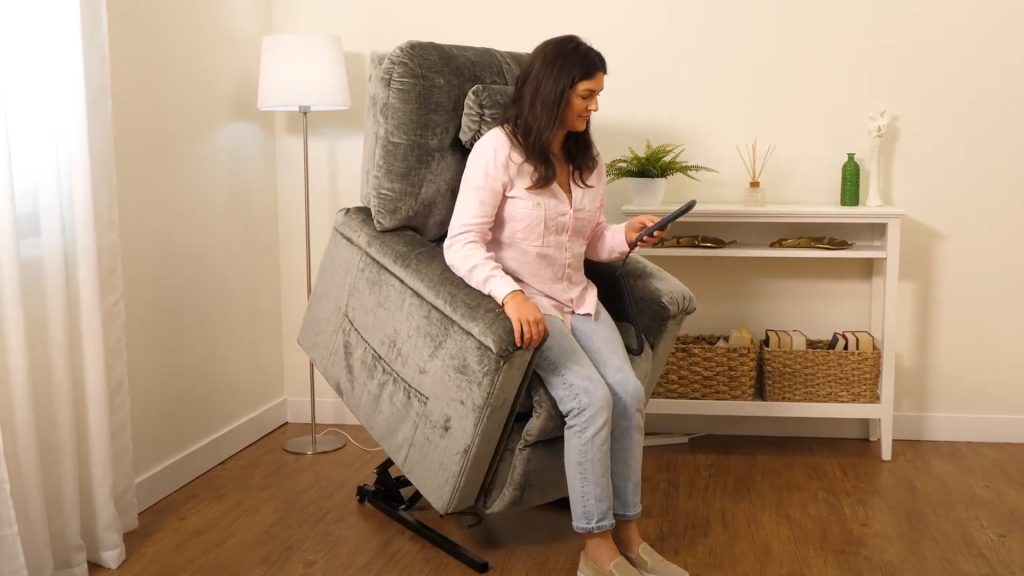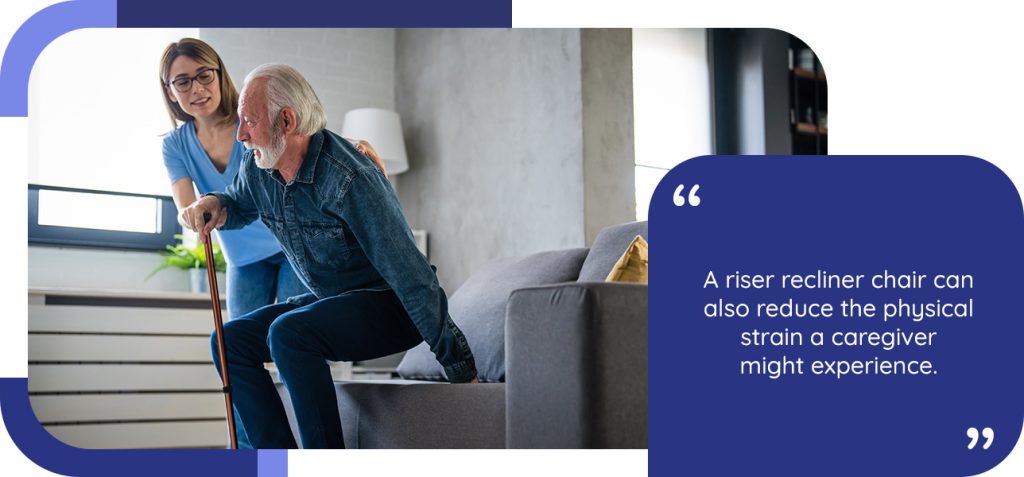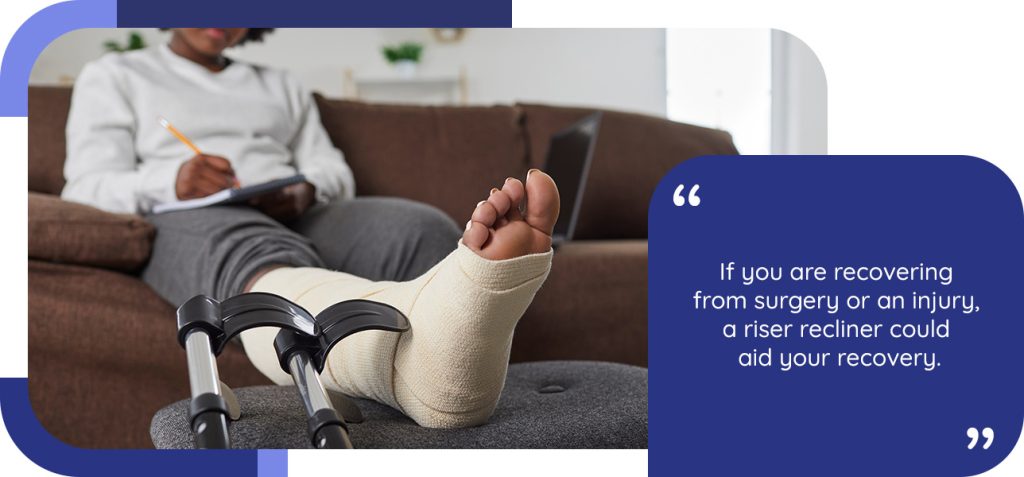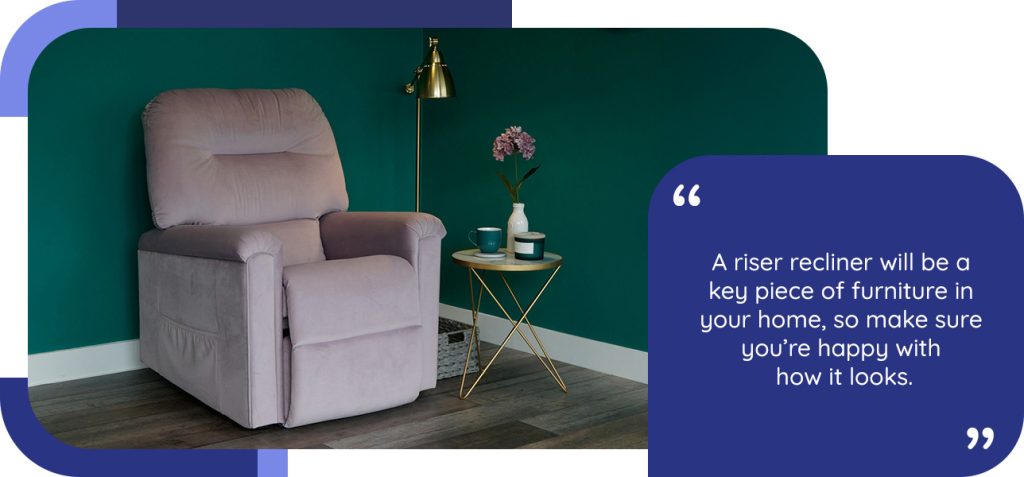Riser recliner chairs: the ultimate guide

Riser recliner chairs are becoming increasingly popular in UK homes, offering a blend of comfort, support, and independence that traditional armchairs simply cannot match.
If you’re wondering whether a riser recliner chair might be right for you or a loved one, this comprehensive guide will help you understand who can benefit from these innovative pieces of furniture.
Navigation guide
- What is a riser recliner chair?
- How does a riser recliner chair work?
- Benefits of riser recliner chairs
- Key features and options
- Styles, sizes, and design
- Who can benefit from a riser recliner chair?
- Choosing the right riser recliner chair
- Getting a riser recliner: trials, funding, and next steps
- Your perfect riser recliner chair is waiting
1. What is a riser recliner chair?
A riser recliner chair is a specialist motorised armchair designed to help you sit down and stand up with ease. At first glance, these chairs look just like standard comfortable armchairs – available in a range of styles and upholstery to suit your home decor – but they include discreet built-in lifting and reclining mechanisms. The chair gently “rises” to elevate and tilt forward, helping you get into or out of the seat without strain, and reclines back to let you relax with your feet up at the touch of a button. In essence, a riser recliner provides both a safe standing aid and a cosy recliner in one unit.
Riser recliners are commonly recommended for individuals with limited mobility, seniors, or anyone who finds a standard chair difficult to use. By offering motorised assistance, these chairs give users greater independence and confidence in their daily routine.
They are not “medical-looking” gadgets; modern designs conceal their motors and lifts so well that the chair still looks and feels like a normal armchair. Many models operate smoothly and quietly thanks to advanced technology, so the movement won’t disturb your household’s peace and quiet.
2. How does a riser recliner chair work?
Riser recliner chairs operate on a simple principle: with the press of a button, the chair moves to support you. When you want to stand up, the seat slowly rises upward and tilts forward, effectively “presenting” you to a standing position. This lift-and-tilt motion gently reduces the effort on your legs and joints as you come to a stand.
To sit down, you can position yourself against the raised, tilted seat and then lower the chair using the control; the chair will do the heavy lifting of bringing you down to a seated position safely. Once seated, you can also recline the chair back and elevate the footrest when you wish to relax – perfect for reading, watching TV, or even taking a nap.
Inside a riser recliner chair is an electric motor (or motors) and a sturdy mechanical frame. Single-motor riser recliners use one motor to control both the backrest and footrest together, so when you recline, the back goes down as the footrest comes up. Dual-motor chairs have two independent motors: one moves the backrest and another moves the footrest, allowing you to adjust your reclining angle and leg position separately for more flexibility (for example, keeping the back upright while elevating your legs). Both types will also include the riser function to lift the entire seat.
All movements are controlled by an easy-to-use handset or panel – usually with simple push buttons or toggles. On dual motor models the control may have a few extra buttons (often 4–5 buttons) to manage the different motions individually, whereas single motor chairs typically use a two-button control. Controls can often be positioned on either side of the chair or come as a handheld remote.
For power, most riser recliners plug into a standard mains electrical socket. They are designed to be energy-efficient, using electricity only when operating the motor. Many electric recliners also come with an emergency battery backup system for peace of mind – this means if there’s a power cut, the chair can still function (usually enough to return it to a seated or lifted position a few times) so you won’t get stuck in a reclined or raised position. The battery backup typically kicks in automatically during a power outage to let you adjust the chair for a limited time.
Modern riser recliners have safety features to ensure a smooth and secure operation. For instance, chairs often have built-in sensors or limiters to prevent the mechanisms from continuing to run if an obstacle is detected. It’s always recommended to check that children, pets, or obstructions are clear of the chair before lowering it, as with any recliner.
Some models include safety locks or removable keys to disable the chair’s movement when not in use, which can be useful in homes with small children.
3. Benefits of riser recliner chairs
Investing in a riser recliner chair can offer a wide range of health and lifestyle benefits, especially if you have reduced mobility or spend long periods sitting. Here are some of the key benefits:
Easier, safer standing and sitting – greater independence
The primary benefit is the way a riser recliner helps you stand up or sit down with minimal effort, significantly reducing strain on your knees, hips, and back. If you usually need someone to help you out of a chair, a riser recliner can restore a measure of independence, confidence and dignity by enabling you to get up by yourself at the push of a button.
By lowering the risk of slips or falls during the act of standing, the gentle lift feature helps maintain independence for older or infirm users who might otherwise struggle to rise from a seated position.
Enhanced comfort and pressure relief
The ability to recline and put your feet up means you can easily shift position and relieve pressure on different parts of your body throughout the day. If you suffer from aches, stiffness, or conditions like arthritis that make sitting in one position painful, a powered recliner lets you adjust your posture at will, helping to prevent your back or joints from becoming stiff and sore.
Many riser recliner chairs offer excellent lumbar support and cushioning, promoting a healthier sitting posture (your spine in a natural “S” curve rather than slumping into a “C” shape) and reducing the risk of pressure ulcers from prolonged sitting.
For those who must sit for extended periods, being able to elevate the legs and recline can also help prevent pressure sores and improve overall blood flow.
Better circulation and leg health
By elevating the footrest and lifting your feet above heart level, you encourage blood flow from the legs back to the upper body. This can reduce swelling in the legs and ankles (oedema) and help with conditions like varicose veins or poor circulation.
Healthcare experts note that a rising leg rest can be particularly helpful if you have swollen ankles or certain medical conditions affecting your legs. Regularly changing from a seated to a more reclined position throughout the day keeps your blood moving and may alleviate leg fatigue.
Relaxation and pain relief
A riser recliner chair doubles as a comfortable recliner for relaxation, which can contribute to your mental and physical well-being. You can easily take a nap or rest in a near-horizontal position if desired, without moving to a bed. The gentle support and cradling provided by a well-padded recliner can help reduce pain by evenly distributing your weight.
Many users with chronic back pain or joint pain find they can sit much longer without discomfort thanks to the improved support and adjustability of these chairs. Advanced riser recliners can also offer therapeutic options like heat and massage, which further help in easing muscle tension and pain.
Reduced strain on caregivers
If you normally require assistance from a caregiver or family member to get up from a chair, a riser recliner can also benefit them – it reduces the physical strain and risk of injury that a helper might experience when lifting or steadying you.
By using the chair’s lift function, both you and your helper can avoid awkward, potentially unsafe movements. This makes daily routines safer and less stressful for everyone involved.

4. Key features and options
When shopping for a riser recliner chair, you’ll notice a variety of features and customisation options available. Understanding these will help you choose a chair that best meets your needs and preferences. Here are some key features to look out for:
Single vs. dual motor
As mentioned, a single-motor chair moves the backrest and footrest together, while a dual-motor chair lets you control them independently.
Dual motor designs typically allow more reclining positions – for example, you could sit upright with your feet raised, or recline your back nearly flat while keeping your feet up. Single motor chairs tend to have simpler controls and may be slightly less expensive.
If you value having your legs up without reclining far back, a dual motor is worth it. If you prefer simplicity and usually change both back and leg position together, a single motor might suffice.
Lift mechanism (auto-lift)
All riser recliners will have a lifting mechanism, but some brands have special technology for smoothness or speed. For example, Adjustamatic’s chairs include an Auto Lift system that gently raises the seat to help you stand and lowers you back down, reducing strain on stiff joints.
When comparing chairs, consider how gradually and quietly the lift operates – the movement should feel steady and secure. Most chairs lift to a near-standing angle (around 30–45 degrees tilt forward) to allow you to step away easily without feeling off balance.
Reclining range and positions
Different chairs offer varying degrees of recline. Some fully recline almost flat (often called lay-flat or sleeper recliners), while others stop at a comfortable TV-watching or reading angle. A few models have a “zero-gravity” position, which elevates your legs higher and tilts your body to distribute weight evenly – this position, inspired by NASA, can provide a feeling of weightlessness and is great for relieving pressure on the spine.
Even if a chair fully reclines, remember it’s not meant to replace a bed for regular sleep. If you need to sleep in your chair often, discuss this with an occupational therapist; in some cases a chair-bed or an adjustable bed might be more suitable for long-term sleep needs.
Tilt-in-space function
This is a more advanced feature on some riser recliners, where the entire seat unit (backrest and seat base together) tilts back in unison, without changing the angle between your back and thighs. This means you remain in the same seated posture as you tilt – which prevents your body from sliding and avoids rubbing or shear on your skin.
Tilt-in-space provides excellent support for the lower back and can be beneficial for users who need to keep a consistent posture or have delicate skin prone to pressure sores. It’s a feature often recommended in healthcare settings for those with high risk of pressure ulcers or who cannot reposition themselves easily.
Space-saving (wall hugger) design
If you’re worried about a recliner taking up too much space, look for a wall-hugger or space-saving riser recliner. These chairs are designed so that as they recline, they move forward on their base, meaning they can be placed just a few inches from a wall without the back hitting it.
Adjustamatic’s Easy Reach® technology, for example, allows placement close to a wall – the backrest slides away from the wall rather than toward it. This not only saves floor space but also keeps your chair in easy reach of items like side tables or shelves.
Materials and upholstery
Riser recliners come in a wide range of upholstery options. You can choose soft fabric or leather, and often the chairs can be ordered in various colours and patterns to match your décor.
There are also practical specialty fabrics available. For instance, waterproof or water-resistant fabric can be useful if incontinence or spills are a concern. Anti-microbial and anti-fungal fabrics are another option—these can resist mould and bacteria. Many healthcare-oriented chairs offer breathable, wipe-clean materials for ease of cleaning.
It’s worth considering not just look and feel, but also maintenance. Choose a material that fits your comfort needs and lifestyle.
Cushioning and support extras
Pay attention to the cushioning and ergonomics of a chair. Many riser recliners have high padded backs and armrests for comfort. You might see different backrest styles such as “waterfall back” (several horizontal pillows that can sometimes be adjusted or padded differently) versus a “button back” or “split back” – each provides a slightly different feel.
Additional bolsters or lumbar support pads are sometimes built-in or can be added to support your lower back. Headrest pillows or neck cushions can also be added, which are useful if you plan to recline often or nap in the chair.
Some chairs even include a “zero-gravity” weight distribution seat system to reduce pressure on your tailbone and hips, making long sitting periods more comfortable.
If you have specific needs (like extra-firm support for back conditions or pressure-relieving foam for pressure ulcer prevention), look for those options or ask the supplier about custom cushioning.
Heat and massage therapy
Many luxury riser recliners have optional heated seats or lumbar heat pads, which can soothe sore muscles or help ease back pain. Massage functions can range from simple vibration massage to more advanced systems.
Adjustamatic’s riser recliners, for example, come with a unique NHC Cyclo-Therapy® massage system, which uses a three-way cyclonic motion (rotating and pulsating in circular movements) rather than just a back-and-forth vibration. This medically-backed massage therapy has been shown to provide pain relief for a variety of conditions – including sciatica, arthritis, oedema, back pain, varicose veins, and poor circulation. You can usually adjust the massage intensity and choose targeted areas or whole-body programs.
Motor and battery noise
Most modern recliners use quiet motors and gearing, but it’s a good idea to test or ask about the noise level. Chairs often emit a soft whirring sound when moving.
If you are sensitive to noise or plan to use the chair in a shared space, you’ll be happy to know that newer models focus on smooth and near-silent operation. Additionally, the transition between positions should be smooth – quality chairs avoid sudden jerks.
The battery backup (if included) is usually a sealed lead-acid or lithium battery that only activates during outages; it typically doesn’t make noise except perhaps a faint click when switching over.
Controls and accessibility
Riser recliners come with different control designs. The simplest are wired remote handsets attached by a cable – these are great because they’re hard to misplace. Some high-end chairs offer wireless remote controls, which remove the tether – just keep in mind you’ll need to keep it charged or replace batteries occasionally.
The controls might have two buttons (for up/down) or a cluster of buttons for more positions. Ensure the buttons are easy for you to press and understand – larger, well-marked buttons are helpful if you have arthritis in your fingers or visual impairments. Many brands also allow you to specify if you want the control on the right-hand side or left-hand side of the chair.
Additional accessories
Don’t overlook the small extras that can make a big difference in daily use. Many riser recliners can be customised with side pockets, cup holders, or tray tables that swing out for meals or hobbies.
If you use a wheelchair or a walking frame, features like removable or drop-down armrests can be crucial – they allow for easier side transfers between a wheelchair and the chair. You might also consider chairs with castors or wheels if you need to move the chair for cleaning or repositioning.
Finally, aesthetic accessories like arm caps/covers or matching scatter cushions can help protect high-wear areas and tie the chair’s look into your living room.
5. Styles, sizes, and design
One concern people often have is whether a riser recliner chair will fit into their home – both in size and in style. The good news is that these chairs come in a variety of sizes and designs, so you can find one that’s comfortable for your body and looks great in your living space.
Size options
Riser recliners are typically available in at least three sizes: petite, standard, and grande (sometimes called large or tall). This is important because for the chair to be comfortable and safe, it should be proportionate to your body dimensions.
A petite riser recliner is tailored for smaller individuals or those who are shorter in height. A grande or large recliner is built with bigger dimensions and a stronger mechanism to accommodate larger or taller users.
When choosing your size, consider seat height, width, and depth: your feet should comfortably touch the floor when seated upright, the seat width should allow a bit of space on each side of your hips, and the depth should support your thighs without the front edge pressing into the back of your knees. If you’re very tall, ensure the backrest height supports your head and shoulders fully.
Style and appearance
Forget the old image of clunky, clinical-looking recliners. Today’s riser recliner chairs come in styles ranging from classic wingback armchairs to modern, sleek designs. You can choose traditional designs with rolled arms, button-tufted backs, and maybe wooden armrest accents, or go for contemporary looks with clean lines and overstuffed cushions.
The key is that the mechanical parts are cleverly hidden inside the chair’s structure. The chair you place in your lounge can match your sofa or other furniture. There are also multiple backrest styles (e.g. “T-back”, “waterfall back”, “split back”), which not only affect the look but the feel of support.
Matched sets and sofas
If you’re worried about a riser recliner looking out of place, you might consider getting a matching riser recliner sofa or companion chair. Some manufacturers offer two-seater sofas or three-seater sofas that match the design of the riser recliner (with the sofa either containing recline functions or just stationary to coordinate).
For couples, there are even double riser recliner sofas so you can sit together and both enjoy the benefits of a riser recliner in one couch. This way, your living room set remains cohesive.
Quality and construction
A well-constructed riser recliner will have a strong frame (often hardwood or robust steel in key areas) to safely lift the user’s weight. It will also have durable fabric/leather upholstery and high-density foam or sprung cushions that retain their shape.
British-made riser recliners, like those from Adjustamatic, often emphasise quality materials and craftsmanship. While browsing, check whether the chair is built to any industry standards or comes with safety certifications. If you plan to use the chair for many hours daily, investing in a high-quality model will ensure it remains comfortable and safe for years.
Look at the maximum weight capacity as well – standard riser recliner chairs might accommodate around 18–21 stone, while bariatric or heavy-duty models can handle more.
Customisation
Remember that many details can be customised when you order a chair. You can often select the fabric, colour, and additional features as discussed. Some providers even let you choose different foam firmness or added lumbar supports.
If you have specific needs, don’t hesitate to ask – there may be a solution. The goal is to end up with a chair that fits you like a glove and suits your home.

6. Who can benefit from a riser recliner chair?
Riser recliner chairs are versatile and can be beneficial for a wide range of people, but they are especially useful if you have mobility challenges or health conditions that make sitting and standing difficult. You might consider a riser recliner if one or more of the following applies to you or your loved one:
Older adults and seniors
As we age, muscle strength and balance can decrease, making it harder to lower into a chair or get back up. A riser recliner offers valuable support for seniors to remain independent at home. It can help prevent falls that might occur when struggling to stand from a low armchair. Many seniors also appreciate the ability to recline comfortably, elevate their legs to reduce swelling, and even take a soothing nap in the chair.
People with arthritis or joint pain
If you suffer from osteoarthritis, rheumatoid arthritis, or other joint issues, you know that bending knees and hips or pushing up from a chair can be very painful. A riser recliner minimises joint strain by doing the movement for you – no need to heave yourself up or risk jarring painful joints. The gentle motion and ability to stop at any point means you can find a comfortable position without aggravating your pain. Heat and massage features can provide therapeutic relief for sore arthritic joints.
Those with back pain, spinal conditions, or injuries
Lower back pain, sciatica, osteoporosis, or spinal injuries can make sitting in standard chairs very uncomfortable. A riser recliner with good lumbar support and the ability to adjust positions can alleviate pressure on the spine and nerve roots.
For example, people with sciatica may find relief by elevating their legs and reclining slightly to take pressure off the lower back. The Cyclo-Therapy® massage system in Adjustamatic chairs is notable for helping with back pain and sciatica symptoms.
If you have a condition like spinal stenosis or a recent surgery, being able to tilt forward into a standing position is also much safer than struggling up.
Individuals with limited strength or muscle weakness
You might not be “old” or have a specific illness, but perhaps a condition like muscular dystrophy, multiple sclerosis, Parkinson’s, or even general frailty due to a prolonged hospital stay has left you with limited strength.
Riser recliners are very helpful in such cases – the chair can compensate for muscles that aren’t strong enough to lift you up or hold you upright comfortably. For example, someone with MS who experiences fatigue can use the powered assistance to stand without over-exertion.
Post-surgery or rehabilitation patients
If you’re recovering from surgery (like a knee or hip replacement) or an injury, sitting down and getting up can be temporarily difficult. A riser recliner can be a fantastic recovery chair. It allows you to sit with support, elevate your leg if needed, and stand with minimal risk.
It’s not uncommon for physiotherapists to suggest using a riser recliner during rehab to aid in safe mobility at home.
People who spend a lot of time sitting or who sleep in a chair
Some individuals, due to health conditions, end up spending many hours of the day in their chair – and sometimes nights too. A riser recliner is almost essential in these cases, because it provides the needed pressure relief and ease of use. It’s much better than being stuck in one static armchair.
However, even if a riser recliner can recline fully flat, it isn’t designed to permanently replace a proper bed. Riser recliners are best for short naps and day rest rather than continuous night sleep, to ensure you get proper posture and pressure distribution.
Anyone with balance or mobility issues
If you use a walking aid or a wheelchair, a riser recliner can help bridge the gap between devices. For instance, some riser recliners have drop-down arms to facilitate a sideways transfer from a wheelchair. If you have balance issues, the chair’s steady lift gives you time to gain your footing securely.
On the other hand, if you have no trouble standing up from any seat, and you don’t spend much time sitting, you may not find it a justified expense. Also, if your home cannot accommodate the chair’s size or you don’t have a convenient spot near an electrical outlet, those are factors to consider.
7. Choosing the right riser recliner chair
Once you’ve decided that a riser recliner chair could improve your life, the next step is choosing the exact model that’s right for you. There are many models and brands out there, so consider the following factors and tips when buying a riser recliner chair:
- Comfort and fit are king: Above all, the chair should feel comfortable and suit your body. Ensure the dimensions match your stature – check seat height, width, and depth. When seated, you should be able to sit all the way back so your lower back is supported, without any gap, and still have your feet flat on the floor. The backrest should support your shoulders and head. If you can, try the chair in person.
- Consider your mobility and health needs: Think about why you need the chair and prioritise features that meet those needs. If you have very stiff knees, you might prioritise a chair that lifts a bit higher and tilts more forward. If swollen legs or circulation is an issue, you’ll want a chair that elevates your legs sufficiently. For pressure management, look for memory foam or pressure-relief cushions built into the chair.
- Single motor vs dual motor: Decide if having the extra flexibility of independent back and leg adjustment is important for you. If you like to fine-tune your position, then a dual motor recliner is worth the slightly higher cost. If you’re content with a straightforward recline and don’t want to fuss with multiple buttons, a single motor will do the job.
- Upholstery and aesthetics: Since this chair will likely be a prominent piece of furniture in your home, make sure you’re happy with how it looks. Choose a fabric or leather that you find attractive and that feels good to the touch. If you worry about spills or incontinence, a dark colour or patterned fabric can hide stains better, or go for vinyl/leather or a chair with a washable cover. And remember to measure doorways and the space in your room to ensure the chair will fit.
- Additional features – must-haves vs nice-to-haves: Make a list of features you absolutely need, and those that would just be a bonus. For instance, battery backup is highly recommended for safety. Massage and heat might be in your “nice-to-have” column. If you know you’ll need to move the chair occasionally, look for wheels or castors.
- Test, if possible: If you can visit a mobility showroom or a furniture store, do test out some riser recliners in person. If visiting a store isn’t feasible, see if the company can do a home demonstration. For instance, Adjustamatic will bring a chair to your home to try, free of charge or obligation. During a home trial, you can verify that the chair fits your space, that you can operate it comfortably, and that it meets your needs.
- Read reviews and get advice: Look at customer reviews and testimonials for the models you’re considering. This can give insight into reliability and how the chair performs in real households. It’s also a great idea to talk to healthcare professionals like occupational therapists or physiotherapists, especially if the chair is for medical reasons.
- After-sales support and warranty: A riser recliner chair is an investment, and ideally you want it to last many years. Check what warranty is offered – typically, you should get at least 1 or 2 years on the electrical components and maybe longer on the frame. Also inquire about servicing. Adjustamatic, for instance, offers an optional home visit every 2 years to check and service their chairs.
- Budget and value: Prices for riser recliner chairs can vary widely. While it might be tempting to go for the cheapest option, consider the value you’re getting: a chair you use every day is worth investing in for comfort, durability, and safety. Look for financing options if needed. Importantly, check if you are eligible for VAT exemption when purchasing – in the UK, if you have a long-term illness or disability, mobility aids like riser recliner chairs can often be sold VAT-free (0% VAT).
- New vs. used, and NHS provision: If budget is a big concern, you might wonder about second-hand riser recliners. It’s possible to find used chairs, but exercise caution: you need to ensure the chair is in good working order and suits your size. NHS or social services may provide a riser recliner chair in certain cases. In the UK, if you have a care needs assessment and it concludes that a riser recliner is essential for you to live independently at home, your local council might supply one on long-term loan or assist with funding.
8. Getting a riser recliner: trials, funding, and next steps
By now, you should have a solid understanding of what riser recliner chairs are, how they work, and what to look for when choosing one. The final step is to make arrangements to get your chair and to integrate it into your home.
- Try before you buy: If possible, arrange to see and try a riser recliner before committing to a purchase. Many companies offer showroom visits or, even more conveniently, home demonstrations.
- Assess your home space: Before your chair arrives, prepare the spot where it will live. Measure the floor space – remember to account for the chair’s full recline length as well as the lift-forward clearance. Ensure there’s a working electrical socket nearby.
- Delivery and installation: When you order your riser recliner, clarify the delivery details. Most reputable companies include white-glove delivery, meaning they will bring the chair into your home, unpack it, assemble it, place it where you want, and plug it in – often even demonstrating the functions for you. Also, consider disposal of your old furniture.
- Training and getting used to it: Once your chair is in place, learn how to use your riser recliner—take some time to familiarise yourself with the controls and features. The first few times, have someone with you if you are worried about using it. Practice going up and down slowly. Find the most comfortable positions for various activities.
- Maintenance: Riser recliner chairs generally don’t require a lot of maintenance, but a few simple habits will keep it in tip-top shape. Keep the motor mechanism clean. If your chair uses a battery backup that needs charging, follow the instructions. For fabric chairs, vacuum the upholstery regularly; for leather chairs, wipe them with a damp cloth and use a leather conditioner occasionally. Consider a service check every couple of years.
- Funding and assistance: If cost is a barrier, explore all options for financial assistance. You may be eligible for VAT exemption, Local Authority funding, or grants from charities. Payment plans are also often available. The priority is to get you the equipment that will improve your life.

9. Your perfect riser recliner chair is waiting
If this guide has helped you see how a riser recliner chair could support your independence, ease daily routines, or simply make relaxation more enjoyable, now is the perfect time to explore your options with Adjustamatic.
Why trust Adjustamatic with your comfort and mobility?
- Tailored to your needs: Whether you need a petite chair for a smaller frame, a grande model for ultimate flexibility, or advanced features like Cyclo-Therapy® massage or zero-gravity positioning, every Adjustamatic riser recliner is crafted to suit your lifestyle, health needs, and home décor.
- Unmatched British craftsmanship: Our chairs are built right here in the UK, combining decades of engineering expertise with quality materials for long-lasting reliability and style.
- Expert guidance from start to finish: From your first enquiry, our friendly team takes time to understand your requirements, explain features, and help you select the perfect model. We offer free, no-obligation home demonstrations so you can try a chair in your own living space before making a decision.
- Comprehensive aftercare: Your comfort and peace of mind matter to us. That’s why we provide full delivery and installation, clear instructions on using your chair, and ongoing support for as long as you own your Adjustamatic product. We can also advise on VAT exemption for qualifying health conditions.
- A solution for every stage: Whether you’re seeking relief from back pain, support after surgery, or simply want a safer, more comfortable way to relax, our riser recliners are designed to adapt to your changing needs—now and in the future.
Take the next step toward greater comfort and independence
If you’re considering a riser recliner chair and want to discover how Adjustamatic can help you find the ideal solution, our expert team is ready to assist. We can answer your questions, provide a detailed brochure, and arrange a free, no-obligation home consultation and trial at your convenience.
Ready to explore how a riser recliner could enhance your daily life? Call us today free on 0800 689 9823 (lines open 9am-5pm Monday to Friday) or send us a message to book your free home consultation.
Experience the Adjustamatic difference—because you deserve a chair that supports your well-being, every day.


